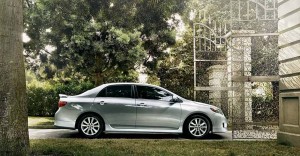
Even during the Cash-for-Clunkers program, Toyota ramped up incentives; now it's offering 0% financing on models like this 2010 Toyota Corolla.
For a month, at least, things almost seemed to be back to normal around the auto industry, assembly lines humming and dealers racing to write up sales orders. But now that the Cash-for-Clunkers program has wrapped up, there’s mounting concern, across the auto industry, that August’s momentum could quickly be lost – or that the industry could be forced to launch a new round of costly rebates and other incentives.
“Cash for Clunkers proved Americans would buy a car if they got a good enough deal – and one available for a limited time,” says Stephanie Brinley, an automotive analyst with AutoPacific, Inc. “But the industry is going to have to come up with some pretty big and clever programs to keep from losing the momentum.”
Despite the big payout from the federal government, new research from Autodata Corp. shows the industry handed out an average $2,265 in rebates, subsidized loans and other incentives, last month, an increase of 31% from August 2008. And there are signs, already, that a big bump may be in the works – notably among Asian makers, like Toyota and Honda, that lag, rather than lead, the rebate wars.
Ford Motor Co.’s Canadian subsidiary has already weighed in with its own Clunkers-style giveback, a $3,000 rebate on trade-ins of older vehicles. Some observers believe a similar plan may be needed in the U.S., as well.
There’s a general agreement that “there will be some payback” from Clunkers, according to Ford’s President of the Americas, Mark Fields. The question is how much. The consensus is that the program “pulled forward” buyers who might otherwise have waited until later in the year, or even into 2010, before coming to market. J.D. Power and Associates has revised its already-weak forecast for next year down from 11.6 million to 11.5 million to reflect this likelihood.
Industry insiders still don’t have a complete handle on just what the Clunkers program accomplished, though the government-funded voucher program appears to have brought many folks into showrooms who actually didn’t qualify for the $3,500 and $4,500 handouts.
“It made people feel it was okay to buy a car again,” says Jim O’Donnell, CEO of BMW of North America. Though most of the German makers products didn’t qualify for the Clunkers program, it did generate about 750 sales for BMW. Meanwhile, a spokesman for General Motors estimates about a third of the increase in sales the domestic maker recorded, in August, came from buyers who were motivated by the Clunkers program, but didn’t actually get a voucher for one reason or another.
“It proved people still want to buy cars,” says analyst Brinley, but she cautions that, “We’ve gotten hooked, as consumers, on getting big cash-back rewards. It seems you need to come up with a couple thousand dollars to get people moving.” And, she says, that could prove all the more true in the next several months.
Manufacturers, on the whole, have actually been trying to reduce rebate spending during the downturn, arguing that it may be better to simply accept the realities of a weak market and instead trim production. Normally, carmakers are loath to take that step, preferring to keep their assembly lines operating, as much as possible, at a steady pace.
That’s been standard operating procedure in Detroit, anyway, while Japanese makers have tended to shy away from offering big incentives, fearing they will have a dangerously corrosive impact – tarnishing a brand’s image and reducing residual values, trade-in prices, in lay terms.
But unusual circumstances often breed unusual results. Ford actually lowered incentive spending by 14% in August. It’s normally frugal Asian rivals went the other direction.
The depth of the current recession has hammered import brands normally immune from economic downturns, Toyota, in particular. The industry giant has seen monthly volumes fall by as much as a third since last year’s collapse of Lehman Brothers sent the economy into a tailspin.
Until recently, Toyota officials liked to insist they didn’t need to use incentives. Well, not exactly. The maker tended to try to avoid mentioning givebacks in its advertising, though it would often provide cash or other financial tools to its dealers to help them close a sale. No longer. These days, Toyota is boasting about the size of its givebacks in just about every TV spot it can air.
That includes 0% financing on normally popular models, like the Camry and Solara, and, notably, the compact Corolla, which actually fared quite well under the Clunkers program, thanks to its high mileage.
Toyota still lags its Big Three rivals in terms of overall spending, but the gap is closing rapidly. According to Autodata, the Japanese maker’s incentives averaged $1,714, last month, just $60 less than Ford’s. Meanwhile, Honda, the second-largest Asian maker, measured by U.S. sales, gave $1,577 in buyer rewards.
None of those makers came close to the incentives offered up by Chrysler, however. The maker’s heavily truck-based line-up — and post-bankruptcy image problems – didn’t fare well in the Clunkers program, even with an offer to double the federal voucher, which drove the maker’s overall August incentives to an average $4,119 a vehicle, a 71% year-over-year increase.
This month, the troubled maker is offering as much as $6,500 on the Ram 1500 pickup to buyers in markets such as Los Angeles. And if the dreaded payback problem hits as hard as some expect, the numbers could go significantly higher. But Chrysler will have the dim satisfaction of knowing it won’t be alone.
